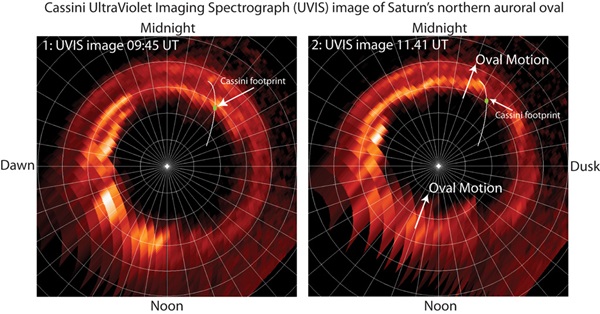Key Takeaways:
Generally, images of the aurora — equivalent to the terrestrial northern lights — provide valuable information about the electromagnetic connection between the solar wind, the planet’s magnetic field (magnetosphere), and its upper atmosphere. Variations in the aurora then provide information on changes in the associated magnetosphere. But viewing the aurora — best done at a large distance — at the same time as measuring the magnetic field and charged particles at high latitudes — where the aurora is found, best done close to the planet — is hard.
In 2009, Cassini made a crossing of the magnetic field tubes that connect to the aurora on the nightside of Saturn. Because of the position of the spacecraft, Emma Bunce from the University of Leicester, United Kingdom, and her team were able to obtain ultraviolet images of the aurora, which manifests itself as a complete oval around each pole of the planet at the same time.
This is the first time it has been possible to make a direct comparison between Cassini images of the night-side aurora and the magnetic field and particle measurements made by the spacecraft. And because of the geometry of the orbit at Cassini, it took about 11 hours to pass through the high-latitude region, or about the same time it takes Saturn to make one rotation.
This meant that the team was able to watch the auroral oval move as the planet turned. As Saturn and its magnetosphere rotated, the auroral oval was tilted back and forth across the spacecraft with a speed that is consistent with a planetary rotation effect.
“With these observations, we can see the simultaneous motion of the electric current systems connecting the magnetosphere to the atmosphere, producing the aurora,” said Bunce. “Ultimately these observations bring us a step closer to understanding the complexities of Saturn’s magnetosphere and its ever-elusive rotation period.”










